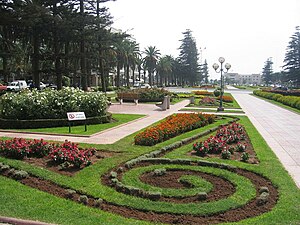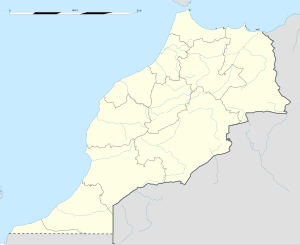Fedala
|
Mohammédia المحمدية ⵍⵎⵓⵃⵎⵎⴰⴷⵉⵢⴰ The city of flowers |
|
|---|---|

Park dedicated to Mohammedia's twin towns
|
|
| Location in Morocco | |
| Coordinates: 33°41′N 7°23′W / 33.683°N 7.383°W | |
| Country |
|
| Region | Casablanca-Settat |
| Population (2014) | |
| • City | 765 890 |
| • Metro | 1 090 768 |
| Time zone | WET (UTC+0) |
| • Summer (DST) | WEST (UTC+1) |
Mohammédia (Arabic: المحمدية, Al-Muḥammadia, Moroccan Arabic: El Muḥemmadiya, Fḍala; Berber: ⵍⵎⵓⵃⵎⵎⴰⴷⵉⵢⴰ) is a port city on the west coast of Morocco between Casablanca and Rabat in the region of Casablanca-Settat. It hosts the most important oil refinery of Morocco, the Samir refinery, which makes it the center of the Moroccan petroleum industry. It has a population of 765 890 (2014 census).
The harbour, at what is now Mohammédia, was originally named Fédala (فضالة). This name comes from the Arabic words Fadl Allah (فضل الله) which means "favor of God". Traces still exist of its business role under the Almoravid dynasty. It was frequented in the 14th and 15th centuries by merchant ships from Europe seeking cereals and dried fruits.
In 1773, the Sultan Sidi Mohammed ben Abdallah made of Fédala a grains warehouse of Tamesna province and built the Kasbah to protect the shops for traders. He built the white masjid Al Atik as well.
During the precolonial period, competition between the Western powers to ensure the economical exploitation of Africa was behind the merger of Europeans interests in the ports of Morocco. In the region of Fédala, the German family Mannesmann acquired a large area of land.
The Treaty of November 4, 1911 between France and Germany on the partition of Africa forced the Mannesmann family to abandon the lands they held for Georges and Jacques Hersent, two French industrialists, who noticed the existence of a natural bay, valuable for the creation of a large port at low cost.
The group Hersent created the Franco-Moroccan company in 1912 and founded the port company in 1914 that took a leading part in the development of Fédala. The rapid growth of the city started around the port, which allowed the development of various industries such as canning fishery products, agro-industry plants, tannery, textile, etc..
...
Wikipedia

